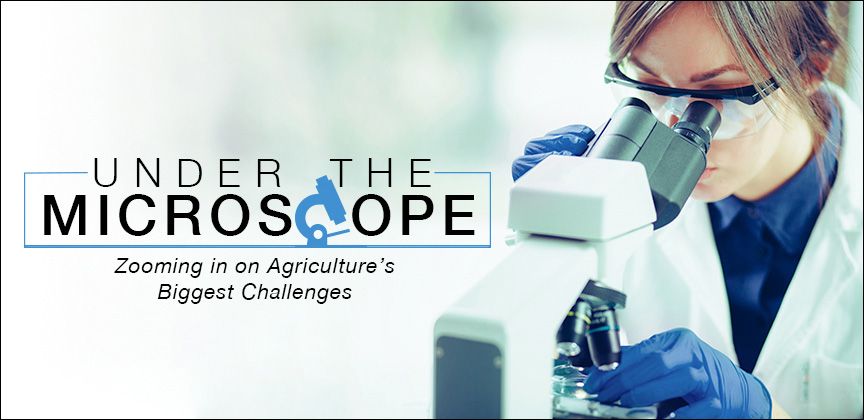
Apr 14, 2020
USDA researcher works on ‘green’ alternatives to chemical pesticides
Jose Ramirez is a research entomologist at ARS’s Crop Bioprotection Research facility in Peoria, Illinois.
He is currently working on developing microbial pesticides for the effective control of mosquitoes and the pathogens they transmit. He recently presented on the mechanisms of mosquito recognition of entomopathogenic fungal infection at the Entomological Society of America Annual Meeting in St. Louis, Missouri.

Welcome Ramirez to Under the Microscope:
UM – Pest management has always been a priority for farmers. How much do insects impact our crops, fields, and yields, and what are the growing concerns with these disruptive insects?
JR – There is an ever-growing invasion of new invasive pests into the United States. These potential new pests, in addition to the ones already established, pose a threat to agriculture and public health. The impact of insect pests to crops runs in the billions of dollars, affecting major industries such as citrus, grapes, avocados, corn, etc.
In addition, arthropod pests also have an impact on human/animal health. For example, mosquitoes and ticks can transmit diseases to humans and livestock. Growing concerns include insecticide resistance, introduction of new invasive species, and the geographical expansion of already established insect pests.
UM – Chemical pesticides are commonly used in agriculture to control pests that can harm crops. Why is there a need for an alternative method?
JR – Chemical pesticides can quickly control an insect pest population, especially covering large areas. They have been essential for the expansion and growth of agriculture and for the control of mosquito-borne diseases affecting public health. However, the persistence of chemical-pesticide toxicity in the environment, their effects on non-target organisms, including humans, and the increase in insecticide resistance demands the need for alternative methods of control that are pest-specific, non-harmful to humans, and do not develop resistance.
UM – What are the advantages of using microbial pesticides, such as bacterial, fungal, and viral insect pathogens, nematodes, and parasitoids?
JR – Microbial pesticides and parasitic insects offer an environmentally-friendly alternative with the potential to alleviate huge economic losses to U.S. agriculture and benefit public health. This process is called biological control, and consists of using the pests’ natural enemies, which can be other insects, bacteria, virus, nematodes, or fungi, to control the pest population.
Some of the advantages of microbial control include reducing chemical pesticide use, improving crop quality, and reducing environmental contamination. In addition, they can be very specific where they target just a specific pest, thus being economical in the long term, and in some cases can be a self-sustaining system. Several scientists at ARS are currently working and evaluating a range of these biological parasites, from nematodes to bacteria, fungi, viruses and tiny parasitic wasps to control a variety of destructive pests.
UM – How does the process work?
JR – It depends on the biocontrol organism to be used. First, we try to discover a “good” natural enemy, which could be a fungi, bacteria, or insect that can kill the target pest. Usually, this is done in the pest’s native habitat. Once in the laboratory, a lot of research is done to see whether it could harm non-target organisms, like bees for example, once it is released into the new location. This is a very important step because we don’t want this new organism to create new problems. Next, research is done to make large quantities of the “good” natural enemy. Here, if we are using bacteria or fungi, they are grown in special containers with enough nutrients that allow them to rapidly grow in numbers. Last, research is conducted to find a way to keep the “good” microbe (bacteria, fungus, or virus) alive for long periods of time. This last step allows for the commercialization of the natural enemy that consumers can use to target specific pests.
UM – What results have you seen with employing biological parasites to kill off a disruptive pest?
JR – There are several successful examples of using this biological pest control approach. A classic example is the use of a tiny parasitic wasp (Encarsia formosa) to successfully control the greenhouse whitefly, an insect pest that feasts on and sometimes transmits viruses that decimate tomatoes and other vegetables. Recently, microbes that naturally kill insect pests in their habitat have been included as active ingredients in several commercially available biopesticides. Fungal pathogens that only infect and kill insects are essential microbial control agents employed against a variety of crop pests, and insects of veterinary, urban, and public health importance.
UM – I understand that mosquitoes have been a particular focus of your work. How can mosquito populations be best controlled, without the use of chemical pesticides?
JR – The best approach is one that integrates several strategies, from chemical to cultural to biological control. With cultural control we can reduce the mosquito breeding habitats by removing reproductive sites from around the house like old tires, etc., that can hold water. Meanwhile, with microbial pesticides we can target the mosquito itself at different life stages, from larvae to adults, thus reducing the mosquito population. These two last approaches enable us to reduce the use of chemical pesticides.
Currently, we are evaluating several bacteria and fungi for their ability to kill larvae and adult mosquitoes. Each of these microbial parasites have a distinct way of killing the mosquito, and we are researching which one is most effective at controlling large populations of mosquitoes. In addition, we are interested in learning how microbial parasites kill the mosquito, what weapons they use, and whether we can replicate it or improve it, so that we can accelerate the kill rate of mosquitoes.






